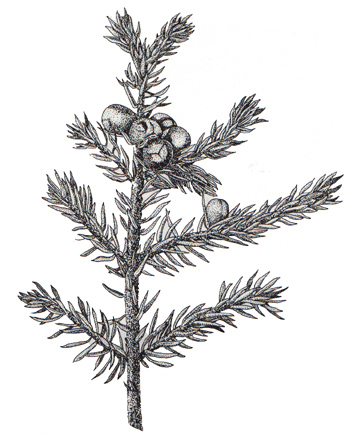

Juniper
Juniperus communis
(Cupressaceae)
Description:
A member of the Cypress family, juniper in Alaska grows
as a shrub with prostrate form and extremely sharp-pointed needlelike leaves.
(There is a rare species in southeastern Alaska, Juniperus horizontalis or
creeping juniper.) The fruits of J. communis are berries, green the first
year ripening to black in the second or third year.
Distribution:
This species is the most widely distributed conifer in
the world and the most widespread tree species in the North Temperate zone.
Constituents:
Volatile oil is found in highest concentration in full-grown but unripe
berries. You should obtain 0.5 ml. of juniper oil from each 100 grams
of berries. The riper the berries, the more of the volatile oil has been converted
to resin. (Spoerke) The volatile oil has been called oil of sabinal. It is obtained
by steam distillation and contains 50% alcohols, primarily 1-terpinen-4-ol,
alphapinene, camphene, and cadinene. (Spoerke) The fruit also contains resin,
sugar, tannin, and a flavone of glycoside. The Merck Index cites juniperin
as a constituent.
Medicinal uses:
Usually the berries are used, chewed raw or steeped into
tea. The major use of juniper by herbalists has been for its stimulant effect
on the genitourinary tract. (Juniper oil is one of the ingredients in many patent
remedies.) Besides its diuretic effect, juniper is used for flatulance, to increase
heat, to stimulate the stomach, to strengthen the brain, for rheumatic pains,
and for problems in the back and chest.
In Alaska, the Tanainas like to burn the needles on top of a hot wood stove as an incense. They say smelling them is good medicine for a cold. I have tried this many times, as I find the odor of smoking juniper needles delightful.
Kari also reports that Tanainas boil branches of juniper in water and drink the tea for colds, sore throat, and tuberculosis. They say it helps a person who has a hard time urinating.
In the Interior of Alaska, traditional medical practice included two uses of juniper for colds: boil berries with leaves and drink 1/2 cup; or boil squashed berries, strain, and drink 1 cup. (Hall)
The leaves were used by the Hopi as a decoction for a laxative or as a drink for women who wanted daughters. Juniper is chewed or given as a tea to women after childbirth, and for twenty days afterward the mother's food is prepared with the addition of some juniper leaves. The mother's body is washed in juniper tea and the newborn baby is rubbed with ashes from burned juniper. When men return from burying a corpse they wash themselves outside the house in water containing a branch of juniper. (Leek)
Goodman and Gilman's The Pharmacologic Basis of Therapeutics (p. 970) mentions a Juniper tar, U.S.P., which is used as a 1 to 5% ointment, 4% shampoo, or 35% bath emulsion. "The medicinal tars are sometimes considered to be antiseptic because of various phenolic components. However, whatever efficacy they have in their uses mainly results from a mild irritant effect. The tars are used in the treatment of diseases of the skin such as psoriasis and eczema-dermatitis."
In herbology of cold remedies many gymnosperms have been used as teas or inhalants to relieve cold symptoms. "The Dakotas, Omahas, Poncas, and Pawnees burned the twigs of Juniperus virginians and inhaled the smoke for colds and also used them in vapor baths; a decoction of the boiled cones and leaves was used by the Plains tribes for treating coughs." (Lewis and E. Lewis)
Copyright © 1987 by Eleanor G. Viereck